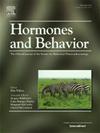微生物群影响小鼠下丘脑室旁核的发育
IF 2.4
3区 医学
Q2 BEHAVIORAL SCIENCES
引用次数: 0
摘要
微生物在哺乳动物新生儿出生时大量定植。我们之前报道过微生物群影响关键的神经发育事件,例如,与常规定植(CC)相比,无菌新生小鼠(“无菌”或GF)在下丘脑室旁核(PVN)中显示出更高的细胞死亡。在这里,我们测试了微生物群可能通过细胞死亡机制塑造PVN发展的假设。为此,我们使用了交叉培养方法,该方法还允许我们测试任何潜在影响是否受到出生时微生物定植的影响,或通过母体微生物群在产前进行编程。具体来说,我们在出生后立即将GF幼崽与CC坝(GF→CC)交叉培养,并将其与微生物状态(CC→CC, GF→GF)交叉培养的对照组进行比较。出生后第7天,GF→GF和GF→CC新生儿的PVN细胞少于CC→CC新生儿,但PVN体积不受影响。在后续实验中,我们证实了成年GF小鼠PVN细胞数量减少,但PVN体积没有变化。因此,先前在新生GF小鼠PVN中观察到的更大的细胞死亡与细胞数量的永久性减少有关。由于在出生时引入微生物群不会改变这种缺陷,我们的研究结果还表明,母体微生物群从子宫开始塑造PVN的发育。本文章由计算机程序翻译,如有差异,请以英文原文为准。
The microbiota shapes the development of the mouse hypothalamic paraventricular nucleus
Microbes massively colonize the mammalian newborn at birth. We previously reported that the microbiota influences key neurodevelopmental events, e.g., when compared to their conventionally colonized (CC) counterparts, sterile newborn mice (“germ-free” or GF) show higher cell death in the hypothalamic paraventricular nucleus (PVN). Here, we tested the hypothesis that the microbiota, perhaps via cell death mechanisms, shapes PVN development. To this aim, we used a cross-fostering approach that also allowed us to test whether any potential effects are influenced by microbial colonization at birth or programmed prenatally via the maternal microbiota. Specifically, we cross-fostered GF pups to CC dams (GF → CC) immediately after birth and compared them to control groups cross-fostered within microbial status (CC → CC, GF → GF). At postnatal day 7, GF → GF and GF → CC newborns had fewer PVN cells than did CC → CC newborns, without affecting PVN volume. In a follow-up experiment, we confirmed a reduction in PVN cell number with no change in PVN volume in adult GF mice. Thus, the greater cell death previously observed in the PVN of newborn GF mice is associated with a permanent reduction in cell number. Because the deficit is not altered by introducing a microbiota at birth, our findings also suggest that the maternal microbiota shapes development of the PVN starting in utero.
求助全文
通过发布文献求助,成功后即可免费获取论文全文。
去求助
来源期刊

Hormones and Behavior
医学-行为科学
CiteScore
6.70
自引率
8.60%
发文量
139
审稿时长
91 days
期刊介绍:
Hormones and Behavior publishes original research articles, reviews and special issues concerning hormone-brain-behavior relationships, broadly defined. The journal''s scope ranges from laboratory and field studies concerning neuroendocrine as well as endocrine mechanisms controlling the development or adult expression of behavior to studies concerning the environmental control and evolutionary significance of hormone-behavior relationships. The journal welcomes studies conducted on species ranging from invertebrates to mammals, including humans.
 求助内容:
求助内容: 应助结果提醒方式:
应助结果提醒方式:


